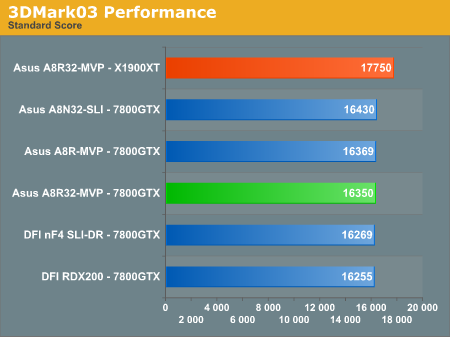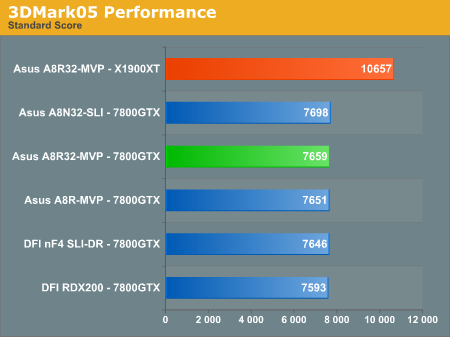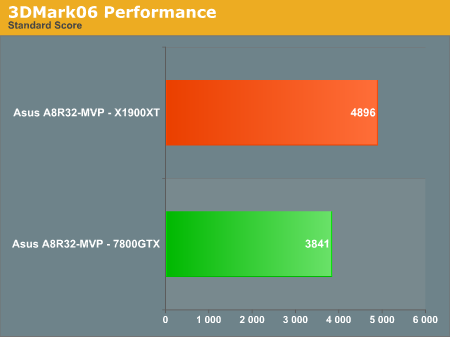Asus A8R32-MVP Deluxe: First ATI RD580
by Wesley Fink on March 1, 2006 9:00 AM EST- Posted in
- Motherboards
Graphics Performance and Encoding
The 3DMark benchmarks, published by FutureMark, are probably the most widely quoted gaming performance benchmarks available. While the benchmarks are based on game sequences written by FutureMark to reveal subtle differences in gaming performance, they still have to be considered synthetic benchmarks. They are useful for broad Graphics comparisons, but they are no substitute for benchmarks with real gaming engines that are currently being played.
3DMark06 was recently introduced and you can find more in-depth information about this new 3DMark at in the AnandTech article Futuremark's Latest Attempt: 3DMark06 Tested.
The 3DMark benchmarks, published by FutureMark, are probably the most widely quoted gaming performance benchmarks available. While the benchmarks are based on game sequences written by FutureMark to reveal subtle differences in gaming performance, they still have to be considered synthetic benchmarks. They are useful for broad Graphics comparisons, but they are no substitute for benchmarks with real gaming engines that are currently being played.
3DMark06 was recently introduced and you can find more in-depth information about this new 3DMark at in the AnandTech article Futuremark's Latest Attempt: 3DMark06 Tested.














65 Comments
View All Comments
SuperStrokey - Friday, February 17, 2006 - link
i assume that was not the gtx512 was it? If so wowDeathBooger - Friday, February 17, 2006 - link
http://www.scan.co.uk/Products/ProductInfo.asp?Web...">http://www.scan.co.uk/Products/ProductInfo.asp?Web...If you do a currency conversion it's $217USD. Some lucky guy actually got to buy it before they were supposed to sell it. http://forums.overclockers.co.uk/showthread.php?t=...">http://forums.overclockers.co.uk/showthread.php?t=...
Egglick - Friday, February 17, 2006 - link
Why would you use two different videocards when benchmarking a motherboard?? This really tells us nothing about the motherboards performance in relation to the others, because you have another huge variable.Wesley Fink - Friday, February 17, 2006 - link
As we stated in the test setup we ran BOTH the 7800GTX and the X1900XT video card on the Asus A8R32-MVP. We reported both results so you could compare 7800GTX performance to the previous boards also tested with the 7800GTX. Since the X1900XT is the latest and fastest video card the results were included for Reference only - many would have asked for X199XT results if they were excluded.As someone else pointed out, when testing Dual X16 Video you have to run SLI on nVidia and Crossfire on ATI (or Intel).
andrewln - Friday, February 17, 2006 - link
because you can not run SLI in Crossfire motherboardstuteja1986 - Friday, February 17, 2006 - link
Why didn't Asus include the cool feel as they did with the ASUS A8N 32-SLI. Like the 8-Phase Power and the cool looking Fanless Motherboard cooling system.mino - Friday, February 17, 2006 - link
Just wondering. maybe 8-phase is a waste for ~60 watt Athlon64s. Also why do a fancy(an expensive) "cool looking Fanless Motherboard cooling system" when chipset is cool and doesn not need one at all???I.m glad someone has a sense and doesn't produce third central heater in the system(after CPU & GPU).
Hoping SB600 will be a good one.
Wesley Fink - Friday, February 17, 2006 - link
The RD580 chipset also ran very cool on this board, so there may not be the need for the more exotic passive heatpipe cooling used on the A8N32-SLI.Wesley Fink - Friday, February 17, 2006 - link
The A8R32-MVP was designed to sell for a lower price - probably around $130 to $150, where the A8N32-SLI was designed to sell for $200+. While the A8R32-MVP isn't 8-phase, it actually overclocked ba bit better and gave up nothing to the more expensive and excellent A8N32-SLI in performance. This board can also run dual X1900XT cards in Crossfire mode.tuteja1986 - Friday, February 17, 2006 - link
I wonder how much will it sell for and if it goes arround same price as Asus A8N 32-SLI (220ish). if it cost that much then i will end up buying DFI RD580 motherboard if its got no issue bugs like the 1st rev of DFI RD480 CRossfire.